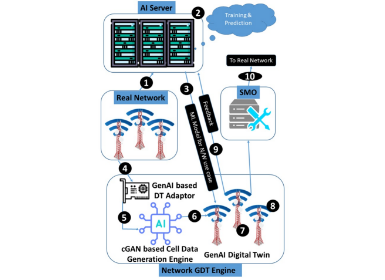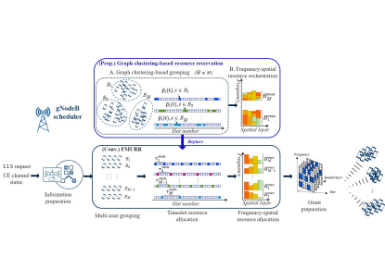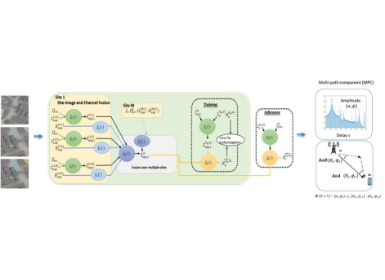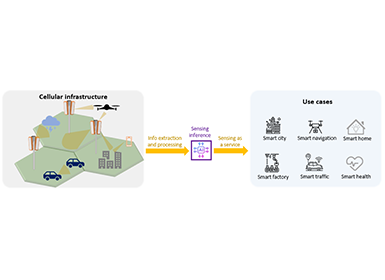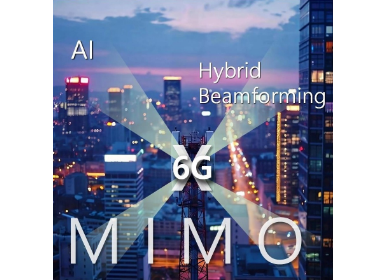Communications
Enable JSCC-based CSI Feedback for B5G/6G: Design, Standardization, and Prototype
1 Introduction
In modern wireless systems, the process of acquiring channel state information (CSI) has become increasingly important and challenging due to the conflicting needs of expanding antenna arrays and achieving high spectrum efficiency [1]. This CSI compression and transmission task is naturally suitable with the auto-encoder frame structure, which captures the intrinsic correlation of CSI in an end-to-end manner that contributes to better compression performance [2], whilst it suffers from adaptation difficulty and “cliff-effect”, which degrades the performance. Recent studies in semantic communication have explored the potential of joint source and channel coding (JSCC) in audio [3], image [4], and video communications [5]. Inspired by these findings, utilizing JSCC strategy to facilitate CSI feedback has been proposed by [6], and demonstrated a superb performance in terms of relieving the cliff-effect and increasing CSI reconstruction accuracy. However, the gap between research and realization is still big. This article proposes a comprehensive JSCC method for CSI feedback, including a technique solution for eliminating the impacts of residential fading and radio frequency (RF) imperfections, and a protocol design to support the realization of the method in cellular systems.
2 Method
This article targets bridging the gap between the research and realization of JSCC for CSI feedback in cellular systems, from the perspective of technique solution, protocol solution, and demonstration. We consider a massive multiple-input and multiple-output (MIMO) system without channel reciprocity, and focus on a CSI feedback procedure for obtaining the precoding matrix at a base station (BS). The target is to maximize the accuracy of reconstructed CSI (i.e., equivalent to downlink throughput) under limited uplink overhead by designing the algorithms and the paired PUCCH procedure for the CSI feedback. The encoding and decoding functions are jointly designed to reduce the average mismatching between the source CSI and the reconstructed CSI. We then propose an imperfection-aware learning approach for the training of an auto-encoder, which enables JSCC-based CSI feedback with the capability to eliminate the impacts of residential fading and RF imperfection. After that, we propose and evaluate the necessary physical uplink control channel (PUCCH) design to support the realization of JSCC-based CSI feedback in cellular systems, specifically, supporting prioritized rate matching.
2.1 Imperfection-Aware JSCC-based CSI Feedback
We consider an auto-encoder architecture for CSI feedback, including a paired encoder and decoder located on the side of UE and BS that enables CSI transmission and reconstruction, respectively. This auto-encoder aims at jointly realizing source coding and channel coding, where the encoder is responsible for generating complex-valued modulated symbols from the CSI source, and the decoder is responsible for reconstructing CSI according to the recovered complex-valued modulated symbols. It is noted that the proposed method is general to support the realization of auto-encoder by any neural network structure.
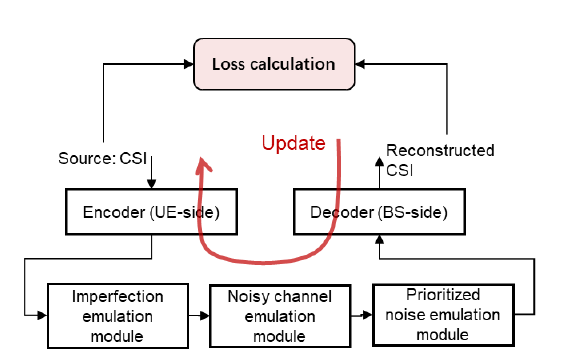
Figure 1. The training procedure of imperfection-aware JSCC
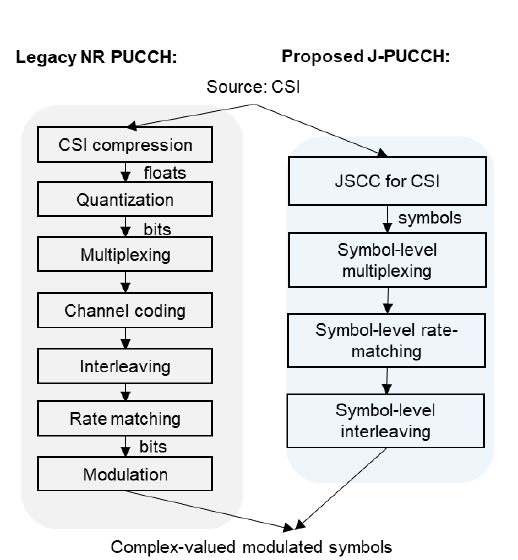
Figure 2. The J-PUCCH procedure
During the training phase, we incorporate three additional functions between the encoder and decoder, as illustrated in Figure 1, which are the imperfection emulation module, noisy channel emulation module, and prioritized noise module. These three functions are represented by a series of non-trainable layers. The first imperfection emulation module imitates the residential fading from channel estimation error and RF imperfections. The RF imperfections consider a general Rapp power amplifier (PA) model [7] with parameters from 3GPP [8]. The residential fading is represented by a sinusoidal function, including a constant parameter that represents the level of residential fading according to the channel estimation capability and a vector represents AWGN noise experienced by the reference signal. After the imperfection emulation module, we include the noisy channel emulation module to imitate the experienced AWGN channel. Finally, the prioritized noise emulation module is incorporated to reduce the impacts of rate matching. The purpose of this module is to have a JSCC model whose output neurons have customized priorities, thus ensuring that complex-valued modulated symbols likely to be punctured carry less important information.
2.2 PUCCH Design for JSCC-based CSI feedback
The legacy PUCCH is depicted on the left side of Figure 2, and the newly defined PUCCH procedure for enabling JSCC, known as J-PUCCH, is depicted on the right side of Figure 2. As observed, the CSI compression, channel coding, and modulation module have been replaced by a JSCC module responsible for generating complex-valued modulated symbols. To maintain the functionalities of legacy PUCCH, multiplexing, rate-matching, and interleaving are still required, and can be performed at the symbol level after the JSCC module. One straightforward approach to enable J-PUCCH is to retain the mechanism of these three modules from the legacy PUCCH, while adapting the objective from bits to symbols. Given that the proposed imperfection-aware JSCC can prioritize its outputs, we also propose a prioritized symbol-level rate-matching scheme to reduce the impacts of rate matching. In detail, the symbols are sequentially stored in a circle buffer according to their priorities, and executing rate matching one-by-one, that guarantee symbols likely to be punctured carry less important information. The detailed circular buffer design is omitted due to space limitations.
3 Results
A hardware proof-of-concept (PoC) test-bed has been developed to validate the feasibility of the JSCC-based CSI feedback. In this section, we detail the PoC scenario, hardware specifications, configurations, and results.
3.1 PoC Introduction

Figure 3. Architecture and signal processing procedure of the PoC
The overall architecture and signal processing flow in the test-bed are depicted in Figure 3. The transmitter emulates the CSI feedback procedure on the UE side that delivers CSI sources, whilst the receiver emulates the CSI reconstruction on the BS side that receives the signal carrying CSI source and recovers it in real-time. On the UE side, RF signals carrying CSI are obtained by sequentially executing AI-based CSI encoding, baseband signal processing, and RF signal processing by personal computer 1 (PC1) running Python, PC2 with LabView, and universal software radio peripheral (USRP) 1, respectively. An inverse procedure occurs on the BS side.
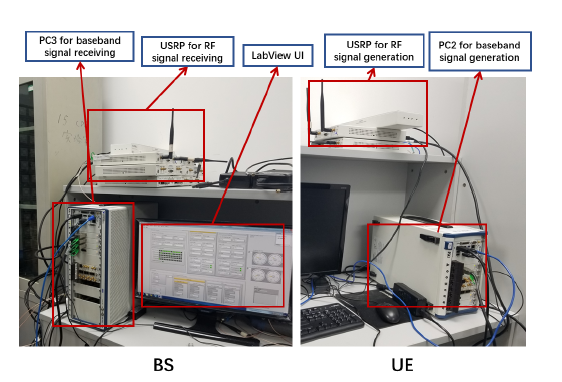
Figure 4. Hardware illustration of BS and UE
We then introduce the realization of both NR-R18 and the proposed IA-JSCC solutions via the developed test-bed. It is noted that the AI model and baseband processing of both solutions are executed in a parallel manner. After that, PC2 multiplexes modulated symbols from both solutions together, and maps them to the shared channel resource. The multiplexing guarantees that the transmission of two solutions experiences nearly the same channel condition. We set the hardware PoC in an office that covers approximately 100 square meters and features an open workspace with partitions, desks, and chairs, as well as glass-walled and brick meeting rooms and corridors in the centre area. Testing is conducted during office hours, capturing employees sitting at desks and moving around the open space.
3.2 PoC Results
We first plot the GCS accuracy as a function of SNR, spanning a range from 3 to 18 dB in Fig 5. Given that the practical environment is dynamic, we plot both the PoC results and their fitting curves. As can be seen, the proposed IA-JSCC (blue curve) surpasses the NR-R18 across all SNR regions. The enhancement of the JSCC method is due to its capability to tolerate minor mismatches without significantly impacting CSI reconstruction accuracy, thus it can utilize continuously modulated symbols that carry nearly infinite information. Additionally, the JSCC method exhibits a less pronounced decline in performance as SNR decreases, effectively mitigating the "cliff effect".
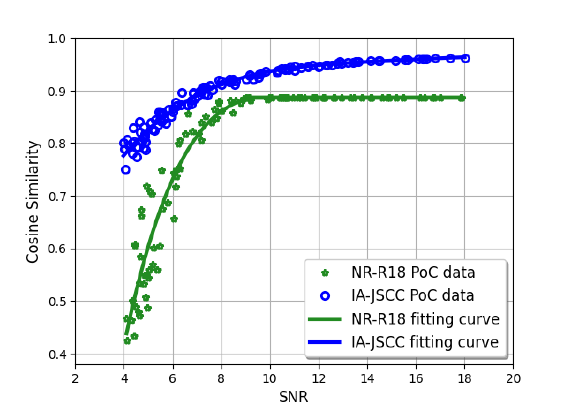
Figure 5. GCS accuracy versus SNR
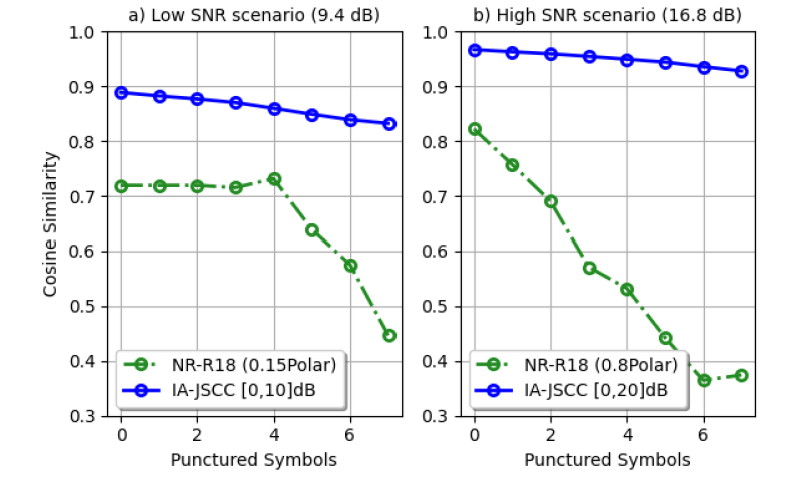
Figure 6. GCS accuracy versus SNR
Figure 6 plots the PoC results of GCS accuracy as a function of the number of symbols being punctured. It's horizontal axis in each sub-figure depicts the number of symbols x being punctured out of the total 33 modulated symbols (i.e., 33-x). It shows that the GCS of the proposed prioritized IA-JSCC (blue curve) degrades only about 5% even with 8 punctured symbols, while that of the NR-R18 reduces about 30% and 50% in low and high SNR scenarios, respectively. This is attributed to the fact that the proposed prioritized solution can efficiently capture symbols that carry important information to be transmitted without puncturing.
4 Conclusion
In this paper, we proposed an imperfection-aware learning approach to enable JSCC-based CSI feedback in practice, which can eliminate the impacts of residential fading and RF imperfections. Furthermore, we proposed a symbol-level PUCCH design to support the realization of this technique. To validate this method, we developed a hardware PoC platform. The PoC results show the proposed approach achieving approximately a 10% improvement in GCS over that of the NR R18 solution. Overall, our work bridged the gap between the research and realization of JSCC for CSI feedback, which paves the way for more efficient and intelligent CSI feedback mechanisms in next-generation wireless networks.
References
[1] Samsung Research, “6G: The next hyper-connected experience for all,” 2020.
[2] J.-C. Shen, J. Zhang, E. Alsusa, and K. B. Letaief, “Compressed CSI acquisition in FDD massive MIMO: How much training is needed?” IEEE Trans. on Wireless Commun., vol. 15, no. 6, pp. 4145–4156, 2016.
[3] N. Farsad, M. Rao, and A. Goldsmith, “Deep learning for joint source channel coding of text,” in IEEE int. conf. acoustics, speech and sig. proc. (ICASSP), 2018, pp. 2326–2330.
[4] E. Bourtsoulatze, D. B. Kurka, and D. G¨und¨uz, “Deep joint source channel coding for wireless image transmission,” IEEE Trans. Cog. Commun. Net., vol. 5, no. 3, pp. 567–579, 2019.
[5] P. Jiang, C.-K. Wen, S. Jin, and G. Y. Li, “Wireless semantic communication for video conferencing,” IEEE J. Sel. Areas Commun., vol. 41, no. 1, pp. 230–244, 2022.
[6] J. Xu, B. Ai, N. Wang, and W. Chen, “Deep joint source-channel coding for CSI feedback: An end-to-end approach,” IEEE J. Sel. Areas Commun., vol. 41, no. 1, pp. 260–273, 2022.
[7] C. Rapp, “Effects of HPA-nonlinearity on a 4-DPSK/OFDM-signal for a digital sound broadcasting signal,” ESA Special Publication, vol. 332, pp. 179–184, 1991.
[8] 3GPP, “TSG R1-163990 preliminary evaluation results for OFDMA based waveforms,” 2024.

